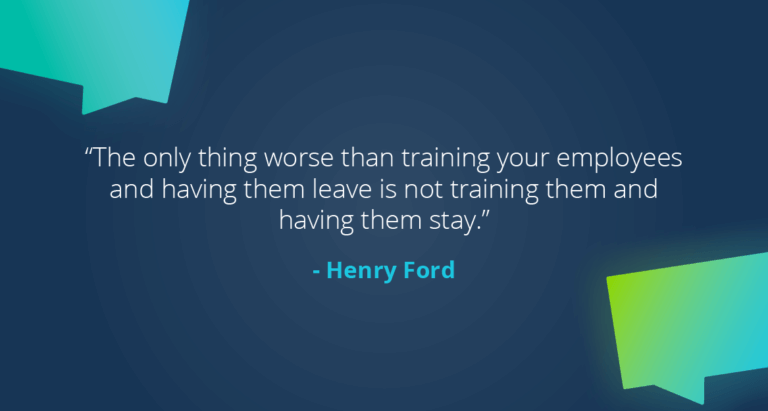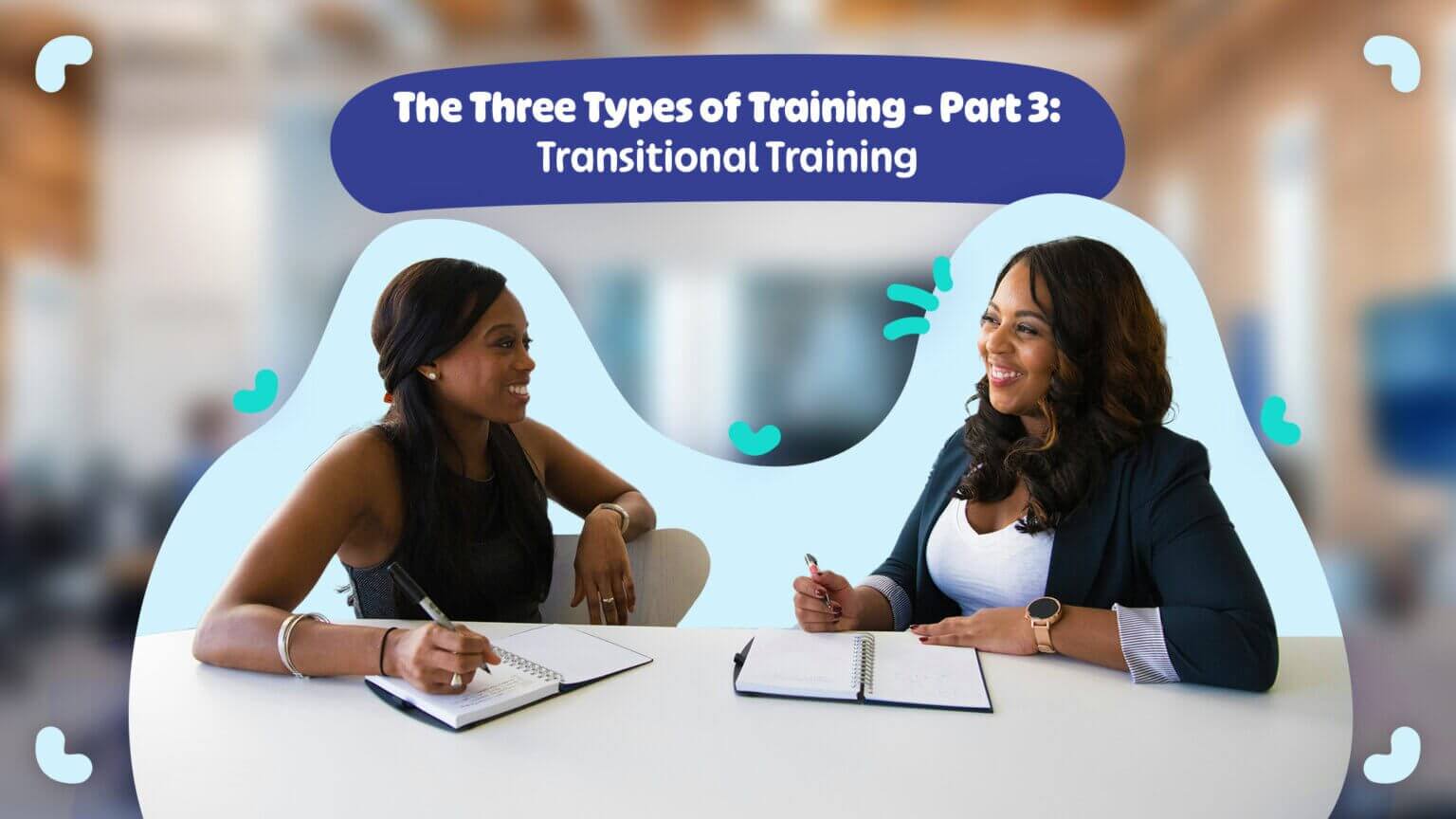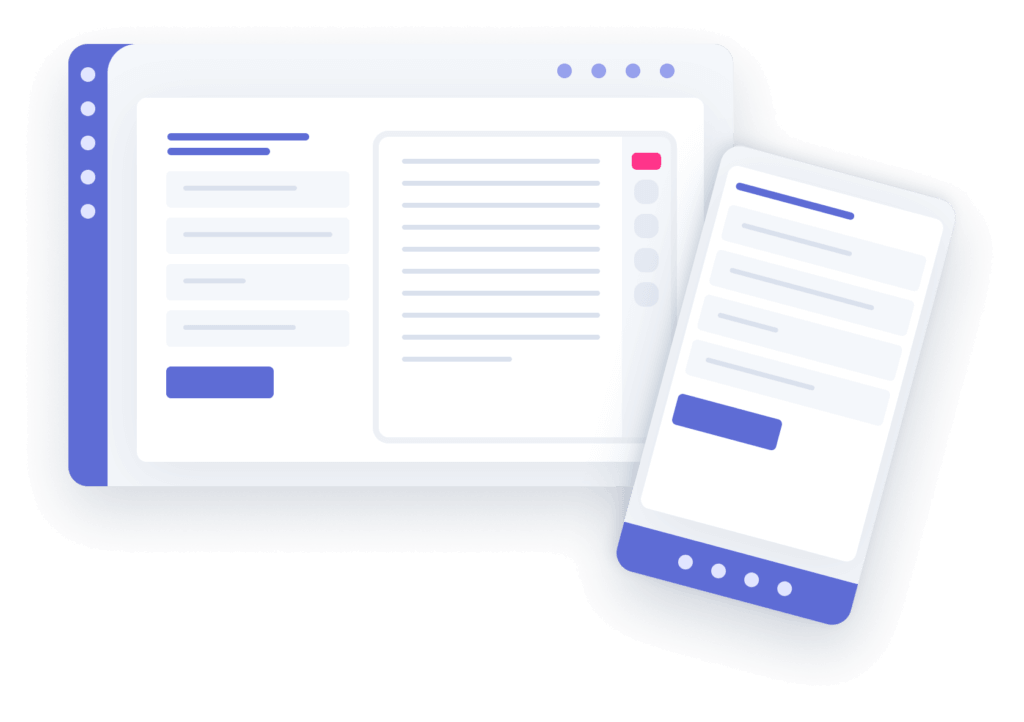Transitional training is a structured program designed to facilitate employees’ seamless movement from one role, project, or department to another within an organization. This type of training addresses the skills gap that might arise when an employee transitions to a new position, ensuring they are adequately prepared to undertake their new responsibilities effectively.
There are a variety of different types of training that are crucial to ensure you’re giving your staff the tools they need to succeed. In this miniseries, we give you everything you need to understand the three most important types of training. In this third part, we’re going to focus particularly on transitional training.
But you can also check out;
What is Transitional Training?
Transitional training is all about equipping employees with the necessary skills and knowledge to move through a transition. This can include a workplace or career transition. Examples include a promotion, change of team or even moving cross-functionally within the organization.
Transitional training is typically needed to develop their individual skills.
Whilst it’s essential to consider the employee’s existing knowledge and understanding, gaps will also likely need to be filled, and this should be managed proactively, as you would with ongoing training. This not only extends to core skills but most likely also to leadership and problem-solving skills.
Any additional policies and procedures relevant to the new role should be considered part of the training, as well as any upskilling required.
Why is transitional training important?
The benefits of training for organizations are lengthy. Transitional training is essential for minimizing disruptions, reducing resistance to change, and ensuring that employees can successfully adapt to new circumstances within the workplace. It ultimately contributes to the organization’s overall effectiveness and resilience.
Enhances organizational agility
In today’s fast-paced business environment, the ability to adapt quickly to changes is crucial. Transitional training enables organizations to be more agile by equipping employees with the skills needed to take on new challenges without a steep learning curve.
Improves employee retention
Employees value opportunities for growth and development. Providing transitional training shows a commitment to their career progression, which can lead to increased job satisfaction and reduced turnover rates.
Boost productivity
When employees are well-prepared for their new roles, they can hit the ground running, minimizing downtime and disruption. This ensures consistent productivity levels across the organization.
How does transitional training work?
Transitional training works by following an employee throughout their time in the business and ensuring they are given the right information and skills at each point in their career as they transition. This could even mean just transitioning to a new software.
By implementing this form of training, you move team members through increasing and incremental depths of involvement and responsibility as time goes on, allowing them to develop confidence and skills in problem-solving, collaborative learning and teamwork, decision-making, organization, and self-responsibility.
Steps in developing a transitional learning model include;
Identification of Skills Gap
The first step in transitional training is to identify the skills and knowledge gaps that need to be addressed. This involves assessing the requirements of the new role and comparing them with the current competencies of the employee.
Customized Training Programs
Based on the identified gaps, a customized training program is developed. This program can include a mix of on-the-job training, mentoring, online courses, and workshops tailored to the specific needs of the employee.
Continuous Support and Feedback
Transitional training doesn’t end once the employee starts their new role. Continuous support and regular feedback are critical to ensure the employee is successfully integrating into their new position. This may involve periodic check-ins, additional training sessions, and performance evaluations.
Where do you begin with transitional training?
Begin by assessing your organization’s training needs in a training matrix. Identify roles that are critical to business operations and determine where future transitions are likely to occur. This will help you prioritize which employees might require transitional training.
Four different areas should be looked into when delivering transitional training to your employees. It’s essential to understand whether training is needed for hard skills or soft skills.
- Focus: On the team member personally, what they offer already, and what is important to them.
- Direction: Where do they want to go in their career? What appeals to them, and how suitable are they for this type of work?
- Adaptability: How adaptable are they to make these changes?
- Self-knowledge and drive: Can they push themselves forward in their careers? Do they have good self-esteem?
Once you have identified these areas for your employee, you can begin building the training process.
What are the components of transitional training?
Key components of transitional training may include:
- Change Management: Helping employees understand the reasons behind the changes and how they will impact their work.
- Skill Development: Providing training sessions or resources to help employees acquire new skills required for their revised roles.
- Communication: Ensuring clear and transparent communication about the changes, expectations, and support available during the transition.
- Support Systems: Establishing support systems such as mentors, coaches, or peer networks to assist employees in navigating the transition.
- Feedback Mechanisms: Encouraging open feedback channels where employees can express concerns, ask questions, and provide input throughout the transition process.

How to create a transitional training program?
As with every form of training, at Whale, we have a recommended structure for developing your transitional training program.
- Conduct a Needs Assessment: Identify the specific changes occurring in the workplace. Determine the training needs of employees based on the upcoming transition.
- Set Clear Objectives: Define the goals of the training program. Ensure that objectives are specific, measurable, achievable, relevant, and time-bound (SMART).
- Design the Curriculum: Develop a structured training plan that covers all necessary topics. Include various training methods to cater to different learning styles.
- Engage Stakeholders: Involve key stakeholders in the planning process. Gather input from managers, employees, and subject matter experts.
- Allocate Resources: Ensure that adequate resources, such as budget, time, and personnel, are available for the training program. Invest in necessary tools and technologies to support the training.
- Implement the Training Program: Roll out the training program according to the planned schedule. Monitor participation and engagement throughout the training process.
- Evaluate and Revise: Collect data on training outcomes and employee performance. Analyze the results to identify any gaps or areas for improvement. Make necessary adjustments to the training program based on feedback and evaluation.
Your ongoing training checklist
Identify Key Roles and Responsibilities
- List all positions affected by the transition.
- Clearly define new responsibilities and tasks for each role.
Assess Skills and Competencies
- Conduct a skills gap analysis to determine training needs.
- Identify both technical and soft skills required for the new roles.
Develop Training Materials
- Create comprehensive training manuals, guides, and e-learning modules.Incorporate a variety of formats, such as videos, quizzes, and interactive simulations
Schedule Training Sessions
- Set a timeline for training delivery, including deadlines and milestones.
- Ensure that training sessions do not interfere with daily operations.
Assign Mentors or Coaches
- Pair employees with experienced mentors for guidance and support.
- Encourage regular check-ins to monitor progress and address concerns.
Utilize Technology and Tools
- Leverage learning management systems (LMS) for efficient training delivery.
- Utilize collaboration tools to facilitate communication and knowledge sharing.
Measure Training Effectiveness
- Establish metrics to evaluate the success of the training program.
- Collect feedback from participants to identify areas for improvement.
Provide Ongoing Support
- Offer continuous learning opportunities and refresher courses.
- Maintain an open-door policy for employees to seek help as needed.
How can Whale help?
At Whale, we pride ourselves on being the experts in employee onboarding and training. We are here to help you reimagine how you train and empower your team, providing the resource for delivering contextual content to your teams in their moment of need and allowing them to learn in a more gratifying and effective way.
Want a recap of this 3 part mini-series on employee training and onboarding? Why not download our eBook "How to integrate and optimize your onboarding processes"?
Bottom line?
Transitional training is an indispensable tool for organizations aiming to maintain agility, improve employee retention, and boost productivity. By investing in well-structured transitional training programs, businesses can ensure their workforce is equipped to handle new roles and challenges with confidence. To further enhance your organization’s training initiatives, consider consulting with our experts to tailor a transitional training program that meets your specific needs.
Ready to get started? Sign up for a forever free plan on Whale.
FAQs about transitional training
Who can benefit from transitional training?
There is a wide range of people who can benefit from transitional training, including:
- Those are moving up the ranks within an organization with new accountabilities.
- An employee using new tools & products within the organization
- Existing workers in precarious employment situations
- Workers experiencing retrenchment and redundancy
- Learning communities and learning organizations
- And more!
How long should transitional training last?
The length of transition training programs typically ranges from a few days to several months. The key factors influencing the duration include:
- Complexity of the Transition: More complex transitions, such as those involving significant changes to technology or job roles, may require longer training periods.
- Participants’ Background: The existing skills and knowledge of the participants can affect the duration. Employees with relevant experience may require shorter training periods.
- Training Goals: The specific objectives of the training program also play a crucial role in determining its length. High-level overview training might be accomplished in a few days, whereas in-depth skill acquisition could take weeks or months.
How do you measure transitional training effectiveness?
Effectiveness can be measured using various methods, including:
- Pre and Post Training Quizzes: Evaluating participants’ skills and knowledge before and after the training to measure improvements.
- Feedback Surveys: Collecting feedback from participants regarding the training’s relevance, content quality, and application in their job roles.
- Performance Metrics: Monitoring changes in job performance metrics, such as productivity levels, error rates, and quality of work, before and after training.
- Retention and Turnover Rates: Analyzing changes in employee retention and turnover rates post-training can indicate the program’s impact on employee satisfaction and engagement.
Are there any legal considerations for transition training programs?
Legal considerations primarily involve ensuring compliance with employment laws and regulations, including:
- Non-Discrimination: Training opportunities must be offered equitably to all eligible employees, without discrimination based on race, gender, age, disability, or other protected characteristics.
- Accessibility: Training programs must be accessible to all employees, including those with disabilities. This may require accommodations such as accessible training materials or environments.
- Labor Laws: Depending on the jurisdiction, there may be specific regulations regarding paid training time, overtime, and other employment conditions.
All of the above will depend on the country in which you reside and the corresponding labor laws.
Get documenting & training NOW
What is your greatest challenge?
SOP & Process Documentation
Use Whale to create SOP & Process Documentation and centralize everything in an easily accessible single source of truth.
Employee Onboarding & Training
Whale is the fastest way to get your team aligned. Discover how Whale boosts team performance and ensures new hires excel from the get-go.
Companies on EOS ®
Whale is the all-in-one system for teams running on EOS® to help document your processes, train your teams, and build a foundation for growth.







